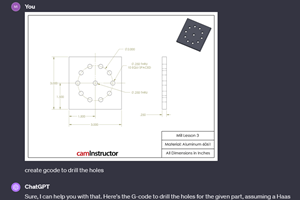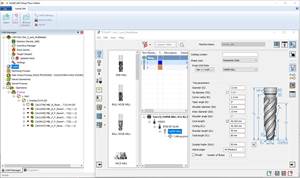Programming Complex Port Surfaces Helps Dragsters Consistently Achieve 300 MPH
The designers of top fuel dragsters are constantly trying to squeeze more speed from their creations. Until recently, they rarely broke the 300 mph barrier.
Share





The designers of top fuel dragsters are constantly trying to squeeze more speed from their creations. Until recently, they rarely broke the 300 mph barrier. This season, however, 300-mph dragster runs have become commonplace. The main reason is the craftsmen who create the cylinder head ports have switched from hand-grinding to CNC machining.
Alan Johnson Engineering makes about half the cylinder heads for National Hot Rod Association (NHRA) top fuel dragsters. The company is only one of three in the United States that builds this type of head. The term "Top Fuel" means that a dragster uses nitromethane as a fuel, which provides about 6500 hp in a beefed-up version of a passenger car engine. The original stock engine is typically rated at 200 to 300 hp.
The cylinder heads used on these engines are about four inches tall, nine inches deep, and 22 inches long. The most critical features on each head are four intake and four exhaust ports. Each port starts with a square hole about two inches wide at the intake manifold and then blends into a round hole while turning 90 degrees to meet the cylinder block. The holes are square on the manifold side, maximizing the cross-sectional volume for higher airflow. They are round on the cylinder block side to match the valves. A valve support, shaped like a shark's fin is built into the hole, further complicating the interior surface design.
As recently as two years ago, virtually all ports for Top Fuel dragsters were ground by hand by highly-trained "porters" who learned their job through years of experience. It takes a good porter about 40 hours of manual labor to grind out the 16 holes required for a pair of heads which costs around $5000.
New heads are frequently installed because it is possible for a drag racer to burn up as many as five sets in a weekend of racing. Then the performance of the engine needs to be backed down by making the fuel mixture richer to ensure that the heads will not burn. Sometimes, the heads are burned out before their performance is optimized.
The key obstacle to overcome was programming the complex internal surfaces on the intake and exhaust ports. The area where the square hole blends into the circular hole is particularly difficult. Alan Johnson Engineering evaluated a number of different programming systems specializing in their ability to produce complex contoured surfaces. Most of these programs ran on Unix workstations and cost in the range of $80,000 and up per seat. But one program, Mastercam from CNC Software, Inc. in Tolland, Connecticut, was found to provide the same surfacing capabilities, including the ability to generate Coons patches and lofted surfaces in NURBS format.
The ability to precisely duplicate ports has allowed porters to focus all of their efforts on getting one port that flows exactly the way they want. A flow bench that measures how much air flows through the port at different amounts of valve opening is a useful tool in this process. After the first port is created and tested, the CNC programmer uses Mastercam to create a program that roughly matches the contour of the port.
A small probe is installed on a digitizer and the program is used to guide its path. The digitizer then very accurately measures the internal surface contours of the part and produces an ASCII file containing the grid of points at approximately 0.050-inch intervals defining the surface. The density of the grid is increased in critical areas such as the valve guide and the area where the hole turns.
These points are then imported into Mastercam. Because they are generated in known order, the software can import them as splines, which eliminates the tedious step of ordering the points. The next step is laying surfaces on top of the splines. The programmers normally use the Coons patch option to define NURBS surfaces.
The final step is defining tool paths. This is normally as simple as selecting the surfaces that are to be machined by a tool and defining the tool diameter. The programmer uses Mastercam's on-screen tool path simulation to check that the cutter path is correct.
Performance has become more consistent because it has become possible to precisely duplicate the intake and exhaust port configurations that provide the best performance. Now that all heads are exactly the same, there is no need to reduce engine performance after switching heads. The result is a significant improvement in performance--in particular, 300-mph runs, which used to happen a few times a season, have now become commonplace. MMS
Related Content
Can ChatGPT Create Usable G-Code Programs?
Since its debut in late 2022, ChatGPT has been used in many situations, from writing stories to writing code, including G-code. But is it useful to shops? We asked a CAM expert for his thoughts.
Read MoreFaster Programming and Training Helps Automotive Shop Thrive
Features that save on training, programming and cycle times have enabled Speedway Motors to rapidly grow and mature its manufacturing arm.
Read MoreBuilding A Powerful Bridge from the CAM Programmer to the Shop Floor Operator
SolidCAM for Operators provides a powerful bridge from CAM programming to the shop floor to best streamline the machine shop process with its CAM part simulation. It provides a clear picture to the operator for setup and prove-out, enables minor G-Code changes and avoids crashes, broken tools and scrapped parts.
Read MoreHow this Job Shop Grew Capacity Without Expanding Footprint
This shop relies on digital solutions to grow their manufacturing business. With this approach, W.A. Pfeiffer has achieved seamless end-to-end connectivity, shorter lead times and increased throughput.
Read MoreRead Next
AMRs Are Moving Into Manufacturing: 4 Considerations for Implementation
AMRs can provide a flexible, easy-to-use automation platform so long as manufacturers choose a suitable task and prepare their facilities.
Read MoreMachine Shop MBA
Making Chips and Modern Machine Shop are teaming up for a new podcast series called Machine Shop MBA—designed to help manufacturers measure their success against the industry’s best. Through the lens of the Top Shops benchmarking program, the series explores the KPIs that set high-performing shops apart, from machine utilization and first-pass yield to employee engagement and revenue per employee.
Read More




















